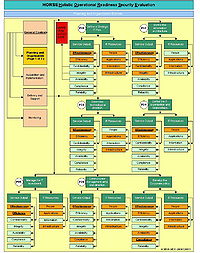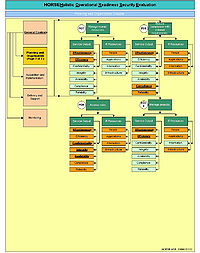Planning and Organization:: Difference between revisions
Joesboxd3b (talk | contribs) mNo edit summary |
m (Reverted edits by Joesboxd3b (Talk); changed back to last version by Mdpeters) |
||
| Line 98: | Line 98: | ||
'''--[[User:Mdpeters|Mdpeters]] 09:42, 27 February 2006 (EDT)''' | '''--[[User:Mdpeters|Mdpeters]] 09:42, 27 February 2006 (EDT)''' | ||
Revision as of 12:26, 26 December 2006
PLANNING AND ORGANIZATION


1 Define a Strategic IT Plan
1.1 IT Value Management
1.2 Business-IT Alignment
1.3 Assessment of Current Performance
1.4 IT Strategic Plan
1.5 IT Tactical Plans
1.6 IT Portfolio Management
2 Define the Information Architecture
2.1 Enterprise Information Architecture Model
2.2 Enterprise Data Dictionary and Data Syntax Rules
2.3 Data Classification Scheme
2.4 Integrity Management
3 Determine Technological Direction
3.1 Technological Direction Planning
3.2 Technological Infrastructure Plan
3.3 Monitoring of Future Trends:| and Regulations
3.4 Technology Standards
3.5 IT Architecture Board
4 Define the IT Processes, Organization and Relationships
4.1 IT Process Framework
4.2 IT Strategy Committee
4.3 IT Steering Committee
4.4 Organizational Placement of the IT Function
4.5 IT Organizational Structure
4.6 Roles and Responsibilities
4.7 Responsibility for IT Quality Assurance
4.8 Responsibility for Risk, Security and Compliance
4.9 Data and System Ownership
4.10 Supervision
4.11 Segregation of Duties
4.12 IT Staffing
4.13 Key IT Personnel
4.14 Contracted Staff Policies and Procedures
4.15 Relationships
5 Manage the IT Investment
5.1 Financial Management Framework
5.2 Prioritization within IT Budget
5.3 IT Budgeting Process
5.4 Cost Management
5.5 Benefit Management
6 Communicate Management Aims and Direction
6.1 IT Policy and Control Environment
6.2 Enterprise IT Risk and Internal Control Framework
6.3 IT Policies Management
6.4 Policy Rollout
6.5 Communication of IT Objectives and Direction
7 Manage IT Human Resources
7.1 Personnel Recruitment and Retention
7.2 Personnel Competencies
7.3 Staffing of Roles
7.4 Personnel Training
7.5 Dependence upon Individuals
7.6 Personnel Clearance Procedures
7.7 Employee Job Performance Evaluation
7.8 Job Change and Termination
8 Manage Quality
8.1 Quality Management System
8.2 IT Standards and Quality Practices
8.3 Development and Acquisition Standards
8.4 Customer Focus
8.5 Continuous Improvement
8.6 Quality Measurement, Monitoring and Review
9 Assess and Manage IT Risks
9.1 IT and Business Risk Management Alignment
9.2 Establishment of Risk Context
9.3 Event Identification
9.4 Risk Assessment
9.5 Risk Response
9.6 Maintenance and Monitoring of a Risk Action Plan
10 Manage Projects
10.1 Program Management Framework
10.2 Project Management Framework
10.3 Project Management Approach
10.4 Stakeholder Commitment
10.5 Project Scope Statement
10.6 Project Phase Initiation
10.7 Integrated Project Plan
10.8 Project Resources
10.9 Project Risk Management
10.10 Project Quality Plan
10.11 Project Change Control
10.12 Project Planning of Assurance Methods
10.13 Project Performance Measurement, Reporting and Monitoring
10.14 Project Closure
--Mdpeters 09:42, 27 February 2006 (EDT)